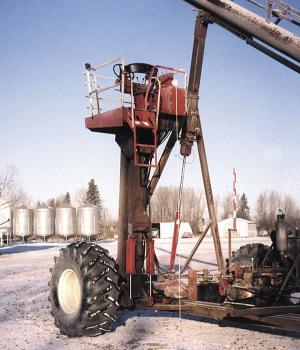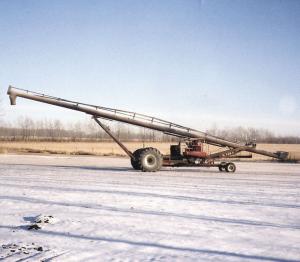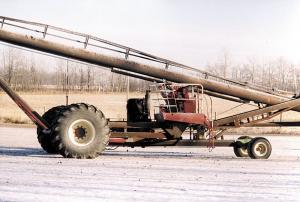He Built The Cadillac Of Self-Propelled Augers
The auger is a pretty important piece of equipment on a big grain farm. Performance, convenience and safety were high on the priority list when Dale Beamish of Jarvie, Alta., recently built what can only be called the Cadillac of self-propelled augers.
The gigantic, yet agile, 13-in. dia. auger is 60 ft. long and has a capacity of about 9,300 bu. per hour.
Beamish took the main tube and flighting from his existing auger and then made a frame from 4 by 8 by 3/8-in. thick wall rectangular tubing, and added a fully hydrostatic ground drive from a 915 IH combine. The steering axle is from a 7700 Deere combine.
The hydraulic pump is belt-driven off the front of the 6-cyl., 251 Chrysler industrial engine.
"I included an engagement lever so you can disengage the hydraulic pumps in cold temperatures," Beamish says. "That way, you can start just the motor without trying to turn the pumps. Once the motor is warmed up, you can engage the belt and let them warm up. It's easier on the motor."
To reverse the auger for handling seed, he takes the drive belt off and twists it. There's a clean-out door at the bottom of the auger that holds about an ice cream pail-full of grain.
The auger itself is mechanically driven from the engine, through a gearbox from an 8650 White pull-type combine. The power is transferred up a power shaft to the end, with a double-60 roller chain.
One of the most impressive features of the unit is the moveable operator's platform that originally came from the same 915 IH combine as the ground drive.
"The whole reason for the moveable platform was to make it easier for positioning the auger in at the top of the bin," Beamish says. "The platform raises up 12 ft. and forward about 8 ft. hydraulically."
Parallel lift arms for the platform are made from 6 by 8 by 1/4-in. rectangular tubing.
From the operator's platform, Beamish can maneuver the rig in any direction, as well as control the height of the auger spout. However, engaging or disengaging the auger can only be done from a control panel at ground level.
The discharge end of the auger can be lowered to the ground by raising the bottom end of the auger. The lift arms are operated by two 4 by 24-in. cylinders. The same-sized cylinders lift the operator's platform. The auger spout reaches up to 34 ft. high.
There's also a 13-ft. cylinder mounted on the underside of the bottom section of the auger. An orange golf ball increases visibility of the locking mechanism setting, which has 26 horizontal positions.
"There are seven holes for locking different auger heights. You can do your finer height adjustments using the horizontal lifting track," Beamish explains. "I have a mechanical latch system that's vacuum-released and spring-applied. It's located on the main lifting track and on the telescopic lift. The reason I used a vacuum is because, as soon as you shut the auger off, it loses its vacuum and the locks go on automatically, so you can never forget to put them on. For safety reasons, you're not relying on the hydraulic system.
"When a bin gets full, it plugs the auger and stalls the engine dead. Obviously, you have to shut the gate quite quickly, and then just move the auger to the next bin, plumb full, and carry on. It starts up without an issue," he says. "I built the drive heavy enough that it can withstand that."
Beamish's unit has seven large working lights for good nighttime visibility.
There's an all-steel hopper built onto the bottom end, and a back-up guide for trucks is an added feature. It works like sites on a gun.
"The auger can either creep, or travel up to 12 mph if need be, but all our grain storage is in our yard," he says. "It's very, very stable. You can travel at high speeds with it way up high. All of our power lines are underground so we don't need to worry about that."
Beamish spent about 500 hours building the rig and says he probably has between $10,000 and $12,000 worth of materials invested in it. Most of the structural material and hydraulics were new.
"We also move fertilizer and stoker coal with it," Beamish says

Click here to download page story appeared in.
Click here to read entire issue
He Built The Cadillac Of Self-Propelled Augers AUGERS Augers 29B The auger is a pretty important piece of equipment on a big grain farm Performance convenience and safety were high on the priority list when Dale Beamish of Jarvie Alta recently built what can only be called the Cadillac of self-propelled augers The gigantic yet agile 13-in dia auger is 60 ft long and has a capacity of about 9 300 bu per hour Beamish took the main tube and flighting from his existing auger and then made a frame from 4 by 8 by 3/8-in thick wall rectangular tubing and added a fully hydrostatic ground drive from a 915 IH combine The steering axle is from a 7700 Deere combine The hydraulic pump is belt-driven off the front of the 6-cyl 251 Chrysler industrial engine I included an engagement lever so you can disengage the hydraulic pumps in cold temperatures Beamish says That way you can start just the motor without trying to turn the pumps Once the motor is warmed up you can engage the belt and let them warm up It s easier on the motor To reverse the auger for handling seed he takes the drive belt off and twists it There s a clean-out door at the bottom of the auger that holds about an ice cream pail-full of grain The auger itself is mechanically driven from the engine through a gearbox from an 8650 White pull-type combine The power is transferred up a power shaft to the end with a double-60 roller chain One of the most impressive features of the unit is the moveable operator s platform that originally came from the same 915 IH combine as the ground drive The whole reason for the moveable platform was to make it easier for positioning the auger in at the top of the bin Beamish says The platform raises up 12 ft and forward about 8 ft hydraulically Parallel lift arms for the platform are made from 6 by 8 by 1/4-in rectangular tubing From the operator s platform Beamish can maneuver the rig in any direction as well as control the height of the auger spout However engaging or disengaging the auger can only be done from a control panel at ground level The discharge end of the auger can be lowered to the ground by raising the bottom end of the auger The lift arms are operated by two 4 by 24-in cylinders The same-sized cylinders lift the operator s platform The auger spout reaches up to 34 ft high There s also a 13-ft cylinder mounted on the underside of the bottom section of the auger An orange golf ball increases visibility of the locking mechanism setting which has 26 horizontal positions There are seven holes for locking different auger heights You can do your finer height adjustments using the horizontal lifting track Beamish explains I have a mechanical latch system that s vacuum-released and spring-applied It s located on the main lifting track and on the telescopic lift The reason I used a vacuum is because as soon as you shut the auger off it loses its vacuum and the locks go on automatically so you can never forget to put them on For safety reasons you re not relying on the hydraulic system When a bin gets full it plugs the auger and stalls the engine dead Obviously you have to shut the gate quite quickly and then just move the auger to the next bin plumb full and carry on It starts up without an issue he says I built the drive heavy enough that it can withstand that Beamish s unit has seven large working lights for good nighttime visibility There s an all-steel hopper built onto the bottom end and a back-up guide for trucks is an added feature It works like sites on a gun The auger can either creep or travel up to 12 mph if need be but all our grain storage is in our yard he says It s very very stable You can travel at high speeds with it way up high All of our power lines are underground so we don t need to worry about that Beamish spent about 500 hours building the rig and says he probably has between $10 000 and $12 000 worth of materials invested in it Most of the structural material and hydraulics were new We also move fertilizer and stoker coal with it Beamish says










